
|   |

|   |
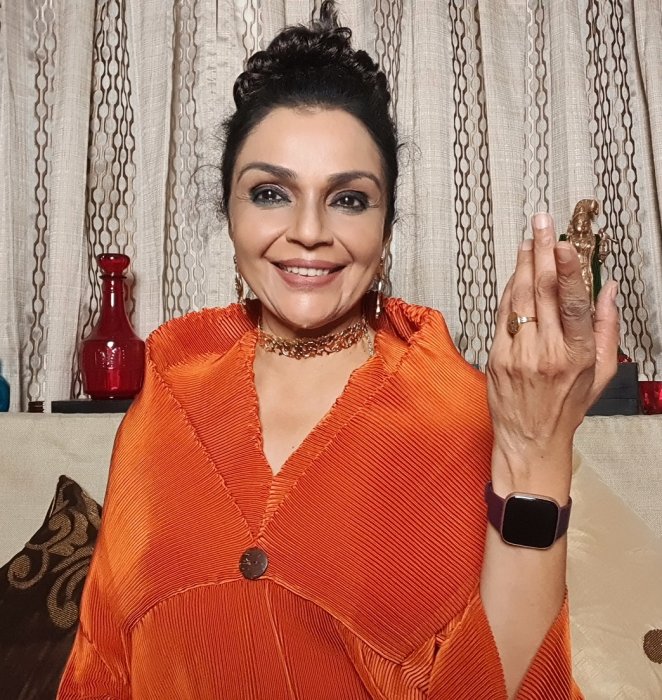 August 2020 Writing the history of the Devadasi with "white ink" is problematic. When the word DEVADASI was substituted with ISAI VELLALAR, the women stepped back and the men stepped forward. The English language is a privilege and a burden. We need a new glossary of terms with which to discuss the dance history of South India. Pass the mic but donít stop speaking. - Quotes from Prof. Avanthi Meduriís Facebook conversation with Dr. Swarnamalya Ganesh on DEVADASI- HISTORY, IDENTITY, POLITICS, PRIVILEGE, July 30, 2020 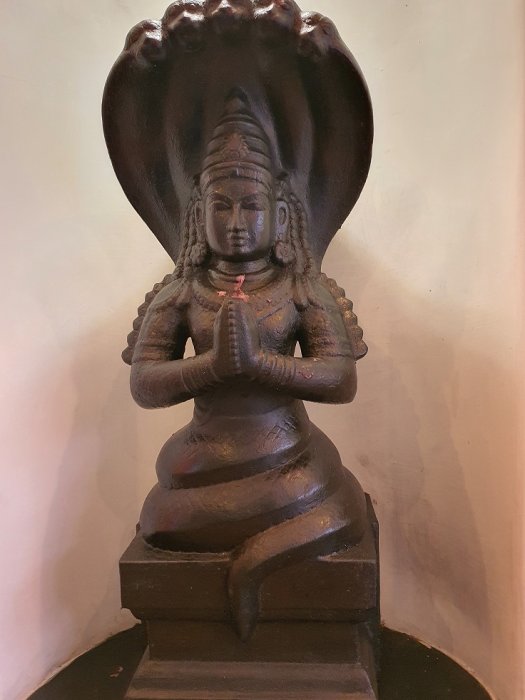 Patanjali There is a beautiful image as imagined by PATANJALI, the originator of Yoga. STHIRAM and SUKHAM - - Stability and Ease It stems from the pose of Vishnu reclined upon the serpent Adisesha while floating on the milky ocean. How adeptly the serpent has to adjust the coils so that the Lord can continue to sleep. For Mahavishnu to experience SUKHAM (ease), Adisesha has to practice STHIRAM (stability-balance). How does one flow in the YOGA OF DAILY LIVING using these two images? How does one live life with these two words as metaphors or gateways to harmony? We now know that these past 4 months are going to last for at least another 8. That this year should now be referred to as #DELETE2020. That we are now locked in a DIGITAL EMBRACE into the first quarter of 2021. So how do we even begin to consider the ideas of STHIRAM and SUKHAM? How can we even fathom these qualities when everything around us is being thrown into disarray? We are off balance more than ever. There is less and less inspiration and motivation to continue to feel optimistic and positive about life and art. So how can we even begin to understand SUKHAM? The cheerleading squad who proclaim that "Dance can surmount anything" now sound weak and unconvincing. We see depression, melancholia and listlessness all around and even the best and strongest among us are feeling vaguely unsettled. No matter how hard we exercise, rehearse, write, sing, paint, sketch, teach and talk over Whatsapp groups, Zoom and Google Meets and via phones and tablets - this pandemic is getting to us. And it has been only four months and we have 8 more to go!!!! August is the month of marking India's 73rd Independence Day. We spoke to several dance seniors and asked them to share a memory of what that day was like! Read the words and thoughts of many revered names in the dance world in our special article AT THE STROKE OF MIDNIGHT I would like to share thoughts - not about the zillion Webinars and online events, but on issues that are emerging during these past months and especially during July. #TA KI TA TOM EVERYONE HAS BECOME A GURU. The youngest fledgling has become filled with "Gyan." That was expected during this pandemic but when they begin spouting wisdom while barely 30, it attacks both my STHIRAM and SUKHAM! I am told, however, that I am out of sync! Tathaastu! TECHNOLOGY is improving some online experiences. NAVATMAN's upcoming dance festival in NYC looks promising with some world premieres. SUTRA's planned multi camera shoot with Ramli Ibrahim's professional expertise will make this event in Kuala Lumpur worth looking out for. SENIOR DANCERS in India have finally come together to demand payment for their online teaching and mentoring sessions. There are several intense learning and process oriented sessions announced with a modest payment. Arts managers, used to FREE talent for 4 months are finally caving in (albeit very reluctantly) to pay a fee for the experience that senior artistes bring to the table. However, content is the key. No matter how big the name and how many awards precede the artiste, only those with interesting and well produced efforts will stand out. WHY DO I DANCE is a global initiative of Kuchipudi dancer Anuradha Nehru in the USA. Her company's response to the global lockdown is to have dancers across generations and styles create short videos stating their reasons for dance being central to their lives accompanied by a short clip. The premiere is planned for August 22nd on their platforms. SOCIAL MEDIA BEHAVIOUR by dancers in their 30s and 40s is strange. Many prefer to either not hit LIKE or write their comments when senior artistes appear or post on social media. Instead, they choose to send private WHATSAPP messages about "how much we loved your talk/session/ideas". Why? Because if they publicly post a comment or appreciation, perhaps their "alignment" with a certain artiste may have them "blocked" by another group who oppose or dislike the said artiste's views. I have one word for these dancers - HYPOCRITES! HACKING AND INFILTRATING Zoom webinars, websites and Instagram handles is on the rise. In Bengaluru, a poetry session called KAAVYAALAAP, organised by Rajan Kamath of NATAKVALAS was bombarded by right wingers shouting "JAI SHRI RAM". My session on DECONSTRUCTING SITA, alongside Namita Gokhale and Chitra Bannerjee went very smoothly! The thought DID cross our minds, especially with the recent tonsuring of a person in Varanasi and the words JAI SHRI RAM painted on his bald pate; and Nepal now claiming both Ram and Sita are Nepalese and not Indian! As I have said many times - RAM has now become RAMBO! 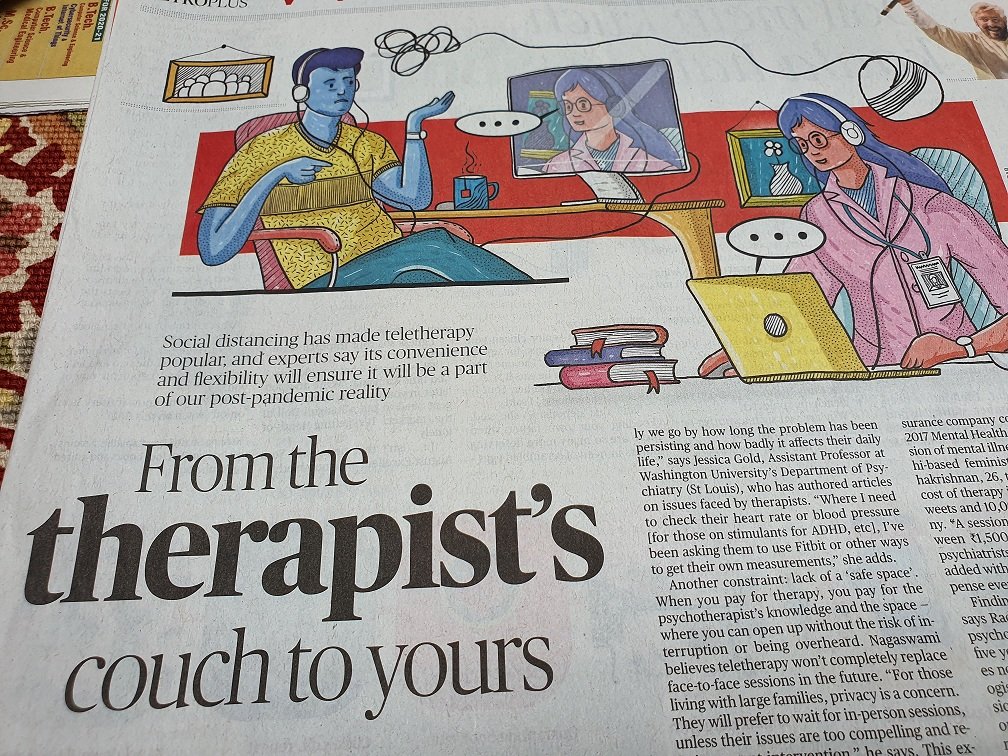 MENTAL HEALTH is a serious issue. Loneliness is a certainty. We don't need high profile suicides or Amitabh Bachchan tweeting about his low mood from a five star hospital. Dancers and artistes need to reach out. So far, the helpline initiated by Srinidhi Chidambaram and Counseller Sabiha Sultana is still open with only a trickle of calls. A delicate matter but an issue that will get more serious as the sense of isolation grows into the rest of 2020. LIFE FOR FOLK PERFORMERS AND RURAL ARTISTES is getting more and more serious. Tamilnadu based arts organizations like ABHAI, SAMARPANA ARTS, SUMANASA FOUNDATION, ARANGHAM TRUST and so many others have collected funds through private donations that account for almost 80 lakh rupees to support those folk artistes whose livelihoods have been threatened. Amidst news of suicides from small towns and villages, we learn that the zonal cultural centres can only give 1000 rupees per artiste as support as per rules! In which Yuga are they living in? A family of four needs a minimum of 3000 to 4000 rupees a month just to put food on the table! The larger question is FOR HOW MUCH LONGER CAN INDIVIDUALS CONTINUE THIS SUPPORT? DESPERATE MEASURES are being sought by many out of work and broke artistes. Some have started selling tea and pakoras outside their homes. Others are contemplating selling their musical instruments. OPENING OF AUDITORIUMS is on the cards in many states. Who will rent them? Who will attend? Who will buy tickets when so much has been offered for free all these months? THE DECEMBER SEASON IN CHENNAI is riddled with uncertainty. Are the events being cancelled? Will they all go online? Will the two dance conferences - NATYA KALA and NATYA DARSHAN - have digital avatars? Will there not be extreme viewer fatigue by then? Watching dance wearing a mask and sitting at a safe distance from another 'rasika' is not what I wish to do. NRI visitors who make up more than half the audience and ticket sales will certainly think twice before travelling. So what will the verdict be? GEETA CHANDRAN'S campaign to reinstate the ECA (extra-curricular activity) quota with the Delhi University has yielded an unsatisfactory decision. She says, "It's unbelievable. Despite the activism and efforts (even the Vice President of India intervened), DU has behaved in an extremely conventional mode and refused to embrace tech solutions while evaluating potential ECA candidates who would get admission based on talent across a variety of artistic disciplines. The University fell into a trap by accepting certificates, and in India, we know that certificates can be purchased and printed even! This decision only perpetuates corruption instead of organizing online trials." "To complicate it further, DU says that they will conduct a forensic examination of certificates. Do they even know what that means?" concludes Geeta sarcastically. #UNDER THE KANNADA SUN Like a lotus that blooms in sunlight, Kathak and contemporary dancer and Artspreneur Madhu Nataraj is having her moment on the global stage. The opening performance of her NATYA STEM ensemble at the INDIA GLOBAL MEET was followed up with a riveting discussion on the arts with Vikram Sampath and Umang Bedi as moderators. The only dancer invited to both perform and speak, Madhu represents the next generation of multi disciplinary performers who wear many hats and juggles her many avatars. Madhu's next appearance is on August 22nd for the RESNICK ASPEN ACTION FORUM where she will conduct a session titled #3 M's - Movement, Mindfulness and Meditation. Scheduled to participate are 450 thought leaders as well as Fortune 500 heads of 40 companies. NATYA's monthly KAMPNI KONVERSATIONS in July featured the co-founder and CEO of Indian Raga, Sriram Emani. Speaking from Boston, Emani spoke with assurance, laying out the breakthrough moment for the company with the Carnatic inspired version of Ed Sheehan's "Shape of You" aired. A student of Carnatic music, Emani has been instrumental in shaping Indian Raga's now global reach with the tag line that reads - MAKING INDIAN CLASSICAL COOL. One cannot argue with success and Indian Raga has gone on to mentor, produce, support and fund original videos of music and dance. While their aesthetic is decidedly "film inspired" and created for camera viewing, (something I may not personally respond to) , it is remarkable to listen to an entrepreneur speak about editing dance videos and the moment when he or his colleagues get bored or distracted while watching the video - that's where the cutting happens. Hmm??? That is reducing dance to entertainment surely, but as I said, you cannot argue with the millions of hits and countless followers of this brand. #MILITARY MANDALAS 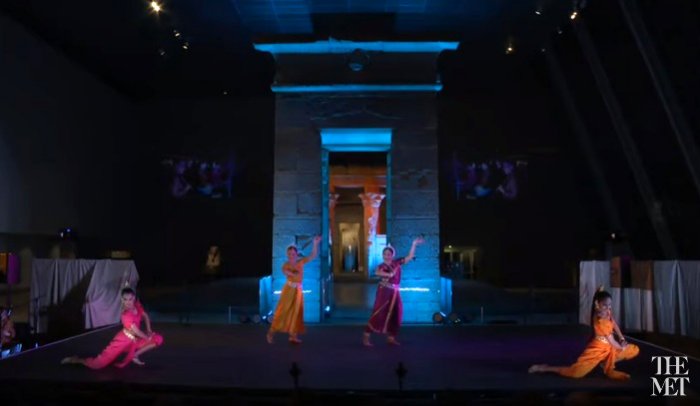 Samhara at the MET I woke up at 4.30am one morning to watch the glorious Nrityagram ensemble at the Metropolitan Museum in New York. SAMHARA is perhaps their most successful collaboration with the Chitrasena Dance Company in Sri Lanka. The multi camera recording of a 2018 performance was a treat to the eyes. Thousands of viewers were watching and marvelling at the symmetry and excellence of the performers against the magnificent backdrop of the Egyptian Temple of Dendur. My eyes were riveted on Thaji Dias, who is the most incandescent soloist of our times. I also watched Bijayini who looked beautiful and picture perfect and I asked myself, "What happened to her?" I ask this question because since 2018, Bijayini has launched her career as a soloist. Her daily Instagram posts of rehearsals in her home studio with the lovely red flooring is a reminder of the rigour she embraces. But how much practice is too much? I watch Bijyani's fluid body, I gaze at her tired face, sitting atop her fluid body which moves to her every command. Is she driving herself too much? If every single movement is rehearsed and decided, then where is the spontaneity? In two years, this gorgeous Odissi dancer who is not yet 50, is looking exhausted. I was also looking at how Bharatanatyam dancer Savita Sastry is drawing lines to show the idea of physical "perfection" that the body needs to create. Straight lines, curves, triangles - these are all becoming like lessons in geometry and mathematics and not art. I am not endorsing slack, lazy dancing. But there has to be an acknowledgment of one's own body, its imperfections and its potential. What is the purpose of dancing 8 hours a day like the Western system of training? Does it actually suit our South Asian bodies? When a dancer waxes eloquently about how she can do the very same adavu all day, my reaction is, " Enjoy the moment. It won't last. Talk to me when you hit 40!" Physical alertness is a must. Fitness is a personal mantra. A rounded and curved body can also be an eloquent communicator. I remember watching a dancer called YALINI who looked so out of place in Chandralekha's troupe because of her generous body shape alongside the other stick thin dancers. During a rehearsal for YANTRA at SPACES, Chandra remarked, "Her body type is inherently like this. But look at her presence on stage!" Many years ago, while serving as editor for the UK dance magazine PULSE, Chitra Sundaram commissioned Mavin Khoo for a series of articles using anatomy and Bharatanatyam training. I remember seeing a page of sketches where Mavin remarked on how to achieve the perfect copybook "araimandi". I also remember thinking, "This is crazy! My body is not a machine." Well, I was wrong because the search for that perfect "araimandi" has led to two generations of dancers sitting in deeper and deeper "plies"- to mostly negative consequences on the lower back and knees. I return to the idea of STHIRAM and SUKHAM. Should not dance be about discipline AND enjoyment? Can one attain both without the apparent drilling of the physique? How can one achieve that state of calm and equipoise if we pound ourselves 10 hours a day? #DISGRUNTLED DANCERS A day after Guru Purnima (July 5) a Facebook post swirled up a shit storm of controversy. A Malaysian dancer posted her personal experiences of abuse from her guru. Without naming her teacher of 17 years in Kuala Lumpur, she went on to recount her trauma of being slapped during her time as a dance student. The post went on to attract a torrent of comments in support of her revelation. I am not an expert on the matter of abuse and certainly do not assume any kind of resolution to this very complex problem in this brief writing. The subject of GURU SISHYA style of teaching and communication in South Asian dance from decades ago until today has always been a complex issue. It needs more discussion and debate than a few paragraphs. I do not mean to simplify or summarise something so deep and hurtful. The wounds of abuse can cause permanent lacerations that are often never healed. There is no excuse for physical, verbal or any kind of abuse. As a teenager, I remember being made to stand outside my class because I was caught chewing gum or listening to the cricket scores on a radio hidden in the back row. I had the TATTUKAZHI thrown onto my ankles in Kalakshetra because my ďaraimandiĒ was not good enough. I have been shouted at - by my teachers - both in school and in dance class. My chemistry teacher slapped me for dropping a test tube filled with mercury in the lab. I cried a few tears but never complained to my parents and they did not arrive in school armed with accusations or allegations of "abuse". The decades of the 1960s and 70s were very different times and I was brought up with the ideas that something worthwhile has to be attained only by a level of sacrifice. Today we live in very different times when the idea of SAFE SPACE is more relevant than ever. The generational shift does not yield easy answers. And these conversations are never simple. Certainly not comfortable to share on social media. The dancer in discussion must have summoned up courage to share what she did. (The above paragraph was edited on August 4, 2020) #ONLINE ARANGETRAMS Two events caught my eye last month. The first was the online arangetram streaming of 16 year old NIKITA RAMESH, student of the Dhananjayans in Chennai. The second was the debut of 15 year old NAYANA SIRIGANA, student of Darpana Academy in Ahmedabad. 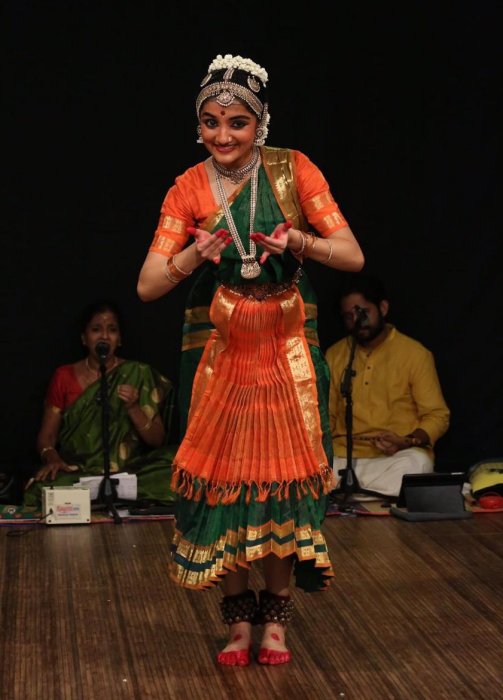 Nikita Ramesh NIKITA RAMESH'S performance was neat and well produced by CP Satyajit, Dhananjayan Sir's photographer son. With slides prefacing each item and the orchestra seated behind the dancer, a matte black curtain highlighting the orchestral ensemble, a well lit stage area and the well rehearsed performer - all came together to make for a very pleasant viewing experience. I watched on my Android phone and noticed the lack of social distancing with the orchestra members. Dancer Shobana Bhalchandra conducted the performance with smooth professionalism. In Ahmedabad, Mallika Sarabhai shared photos of the gorgeous space getting prepped for her premiere online Dance Aradhana. The dancer's parents were present while the relatives and friends watched on ZOOM. The singer, nattuvanar and emcee were not masked but all other musicians and technicians wore masks and were seated safely apart. The performance was not live streamed but Mallika said that this was a successful test case for Darpana to continue. One clear winner in this Arangetram scenario is the reduced costs for the dancer's parents. No dinner. No gifts and goodie bags to all the visitors and friends. No endless chief guest speeches and shawls. #INSTADEVIS  This four month lockdown has made me spend some time exploring Instagram. While certainly a tool for the young, I was shocked and surprised to see the large fan base for some dancers. Just look at this list... Manju Warrier: 1.2m Rukmini Vijayakumar: 304k Mayuri Upadhya: 201k Shobana: 195k Swarnamalya Ganesh: 50.5k Radhe Jaggi: 50.4k Rama Vaidyanathan: 32.8k Janaki Rangarajan: 29.1k Kavya Muralidharan: 28.6k Nirupama Rajendra: 28.6k And now compare with the more famous world renowned and award winning senior artistes. Bijayini Satpathy: 22k Aditi Mangaldas: 11k Geeta Chandran: 9674 Vyjayanthi Kashi: 2835 Madhu Nataraj: 2106 Sharmila Biswas: 1687 Ananda Shankar Jayant: 1495 Madhavi Mudgal: 1254 Sujata Mohapatra: 1249 Leela Samson: 1064 Sonal Mansingh: 1033 Mallika Sarabhai: 591 I expect Rama Vaidyanathan and Bijayini Satpathy to have the followers they do. Bijayini's daily Insta rehearsal posts get more than 5000 views. Rama is a global Bharatanatyam icon with her relentless workshop and item teaching model. The other seniors have obviously not focused solely on growing their Insta followers. Having an Instagram handle is one thing but "feeding" it constantly is totally something else. When I see the large numbers against some of the younger dancers, it is clear that an Instagram following does not translate into real "bums on seats" audiences. Yet, there is clear aesthetic that gets views. Agility, speed, body lines, rehearsal routines - many with the heavy "filmi-cinema" patina. Meditative slowness is out. Nuance is a thing of the past. Abhinaya does not suit Insta medium. #CANCEL CULTURE 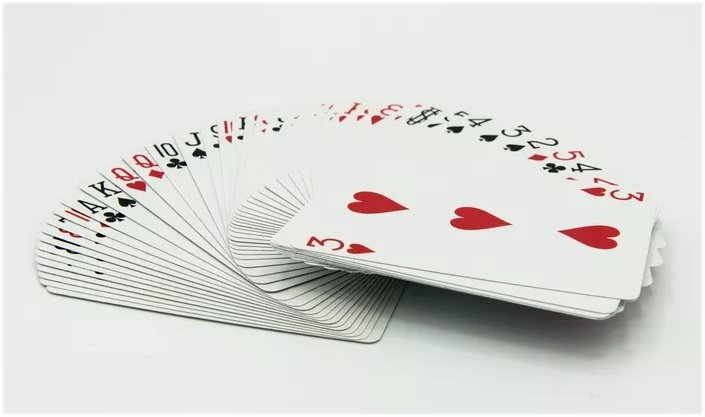 PRESENTISM is a way of dragging an issue, event or historical reference into the present and re-looking at it with the lens of politics and sociology of the present. Like dealing a deck of cards every 5 years. The hand of the dealer is the same. The players at the table are not. It is an awkward and unsatisfactory exercise. Like the recent controversy of using the Durga /Mahisha myth to argue the caste issue in Tamilnadu. That Mahisha the bull is a Dalit ancestor and that Goddess Durga is the symbol of Hindu patriarchy of the upper caste! That being vegetarian itself is an upper caste privilege! That being SAVARNA is a blot on the social landscape and that those of us who occupy that position of privilege should feel ashamed and apologise to those whose lives have been "marginalised, erased, annihilated." For my generation of post Independence professional dancers and the generations that have followed us into the new century to be told to "step aside" and "pass the mic" is not the call of the hour. There is space for everyone, every body type, every voice, every opinion - especially now. In short, CANCEL CULTURE works towards the quick and ruthless elimination of anyone who speaks or acts in a way that is considered politically incorrect. Journalist Vaishna Roy writes pertinently in THE HINDU in an article titled A LITTLE CANCEL GOES A LONG WAY: "This has led to public shaming, trolling, demands for social boycott and even job losses." The article goes on to state that "political narratives are being wrested away from traditional actors." In the world of dance, we are not faced with loss of employment in most cases. We are staring at a small clutch of self obsessed people who are wanting to push the main stage players and grab the spotlight from the current group of talented and successful performing artistes. Their only agenda is not to supplant it with a different aesthetic of good dancing, or even engage in mature discussions. Instead, it is only to bully and browbeat anyone and everyone who is not on their side and try to dismiss them with the phrase "Savarna white washing." Politically correct words are being replaced daily. WOMAN has now become WOMYN or WOMXN. Or has it? We know now that we have moved from LGBTQ to LGBTQIA+. Currently many South Asian artistes in the USA are identifying themselves as POC - Person of Colour. Or BIPOC- Black Indigenous People of Colour. We are catching up. My generation may be slower to these swift changes, but we are learning. Like the use of pronouns She/Her/He/Him/They. Let's take the words ISAI VELLALAR and DEVADASI. We are informed that the correct phrasing now is HEREDITARY COURTESAN DANCE COMMUNITY. Who renamed it thus, I wonder? The phrasing is awkward, removing the traditional dance artiste even further from her South Indian roots. Let that sink in. The problem, as Vaishna Roy argues, is that the cancel culture circle "tends to shoot first. And it shoots more people on its own side than the other." Arts curator Nithya Nagarajan says, Let anger not become your practice. If your anger becomes the entirety of your practice, your practice will only exist in relation to that injustice - in which case, they've already won." This OTHERING is also problematic, THEY - US - THEM. It deepens the divide among the group of dancers and teachers and everyone in the Dance Arts. It continues to include only the same set of names that are firmly focused on screaming, shouting and blaming with, let me add, an eye firmly planted on the next media opportunity. If one expects an engagement or discussion, you will be waiting forever. This group will accuse but rarely engage. Dance scholar Avanthi Meduri summed up this argument on a post addressed to Bharatanatyam dancer Aranyani B. Aranyani had defended her 2017 TEDX talk about Devadasis which came in for fire from the "cancel culture" group. Dr Meduri says - "... this controversy has been reduced to reductive, identity politics. If we want to take seriously this question of the subalternity and disempowerment of the devadasi women, we must begin with the question of translation and the politics of the English language which is central to the discussion." My suggestion to the generation of serious dancers who have made this art central to your lives is this. Be a student every day of your life. Develop the creative confidence to ask questions. Do not be swayed by one book or one person. Reach out to traditional artistes from every style. After all, let not the squabbles in Tamilnadu or Andhra Pradesh influence your opinions about dance history across India.. Watch and listen to interesting web sessions on Caste Politics moderated by Radhika Ganesh for YOUNG PEOPLE FOR POLITICS on Facebook. Some of the Dalit activists and feminists pose interesting viewpoints that are not so simple as Black and White. Search out the beautiful documentaries on the traditional gurus, like the latest posting of the Sangeet Natak Akademi on Guru Subbaraya Pillai. Read the interesting blogposts of SATHIR DANCE ART carefully curated by Jeetendra Hirschfeld on Facebook. Try to read Aniruddha Knight's fascinating posts about his illustrious ancestors. Catch up with the new TALKING DANCE SERIES launched by Swarnamalya Ganesh on her Facebook page FROM THE ATTIC. The first episode was a very interesting talk with Professor Avanthi Meduri. Topic: DEVADASI- HISTORY- IDENTITY-POLITICS - PRIVILEGE. There are several artistes from the hereditary courtesan dance communities who continue to practice in India. It is important to seek them out and listen to their stories. Remember, there is no ONE STORY, ONE HISTORY OR ONE STRAND OF EVENTS. As I have said repeatedly - the facts are complex, often tragic and certainly not comfortable. Finally, DANCERS- STAND UP FOR YOUR ART AND YOURSELVES. #BOXED AND BEYOND Congratulations to the 18 selected artistes in our two editions of the PEOPLE'S CHOICE and CRITICS' CHOICE. To each we have offered a special mentoring gift. Whatever be the dream. To interact with one senior professional in the areas of choreography, theatre, voice culture, dramaturgy, grant writing, story boarding, lighting, costume design, music inspiration - a nudge to continue the creative journey. We have already started pairing dancers with the seniors. We are delighted to be a part of their continuing progress. #NARTHAKI - A NEW AVATAR  20 years after our digital debut, we are birthing a new baby. NEO NARTHAKI - N2, a smart, young and fresh offering from the NARTHAKI family. Aimed at dancers and creative dreamers between ages of 16 to 40, this digital baby will emerge in the next few weeks. As the world changes, we at TEAM NARTHAKI realise that we are all in our fifties and sixties - Lalitha Venkat, Raksha Patel and Sumathi. So it is time to step back and allow new voices and new faces to be seen and heard. Our wish, at TEAM NARTHAKI is to stimulate and encourage a new generation - to engage via social media and all the gadgets now available. To speak, discuss, share, perform and create a more equitable and open space where art and art making is the central focus, with dance as the fulcrum. Let us bring politics, economics, history, health, lifestyle and gender into the mix. Let us look at the many roles that young dancers are playing - juggling their lives all around the world while staying connected to the dance art. I am so excited for the arrival of NEO NARTHAKI. N2. My newest baby! I hope you can welcome "her/him/he/she/they" into the new world where there is so much to create and celebrate. We have only 5 months to the end of ANNUS HORRIBILUS. Let us count the days to 2021. Meanwhile, continue to stay healthy, wear your masks no matter what the ANTI MASKERS (that is now a thing) in the USA are saying. If you don't feel like dancing, don't worry. Keep your body in play - exercise, yoga, singing in the shower, painting, sketching, crocheting, knitting, sewing, planting herbs on your terrace or balcony, cooking, baking, chopping vegetables, getting a pet to shower your affection on, treating yourself to an aromatic herbal massage (DIY of course). I love the black and white images floating across my screen of dancers in the latest fad of posting and sharing a prompt called CHALLENGE ACCEPTED. The real challenges that lie ahead are far more complex than a lovely image, or the chaotic madness of INDIAN MATCHMAKING on Netflix. 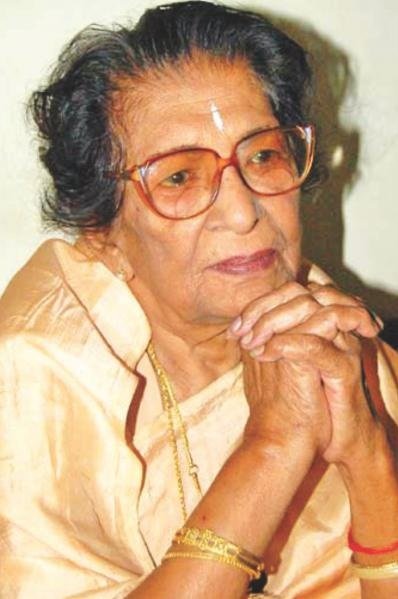 Amala Shankar We end with a salute and Pranam to the iconic Amala Shankar, who bid Adieu at age 101. An era ends! We urge you all to seek out the film KALPANA on YouTube and watch how the visionary Uday Shankar, father of modern Indian dance, created this seminal film. If you watch really carefully, you can see faint backdrops of GEMINI STUDIOS's famous chariot scenes of their earlier mega hit CHANDRALEKHA's giant drum dance. KALPANA was shot in Madras at the famous Gemini Studios and Uday Shankar had run out of money towards the end and had to make do with whatever was available! The back stories of this film are epic. We send greetings to all our readers and followers for this month when several Festivals are marked. Raksha Bandhan, Avani Avattam, Ganesh Chaturthi and Janmashtami. Celebrate while maintaining all health and safety measures. Enjoy the moment and prepare for a very uncertain future. Remember... STHIRAM and SUKHAM... Stability and Ease. Let that be your motto for the month! - Anita R Ratnam Still here - Chennai And waiting for an e-pass to travel to Auroville (Tamilnadu) NOTE A statement about some references in the August 2020 editorial "Anita Says" in narthaki.com I have come to realise that certain statements made by me in the paragraph titled DISGRUNTLED DANCERS in my August blog has angered and distressed many. The incident that was referred to involved a dancer and her unpleasant experience with her guru in Kuala Lumpur. My understanding of the incident from the dancerís Facebook post was coloured by the generational memories of my own growing years. However, this is not an excuse for the painful wounds and strong reactions that I seem to have triggered with several readers. And the larger issue of the victimís vulnerability. I have and never will, condone violence against women. I stand in solidarity with all the victims of abuse. I refuse to be called a rape apologist. And no violence can be soft peddled, brushed under or discussed in passing. In the glare of todayís focus on gender, sexuality and womenís rights, I do not wish to be seen as a Savarna woman justifying child abuse. My writing seems to have suggested exactly what I wanted to avoid. That the victim, a young woman, was to blame for what she experienced many years ago. Even if the incident was shared by the dancer on her own social media page, I should have not named her in my article, thereby exacerbating the already painful situation. It was insensitive and careless of me to write about a situation that I am not fully informed about. These pandemic times are when a measured and calm tone is the call of the hour. That I need to listen more and take pause. To realize that observations of the rapidly changing world has to be accompanied by more understanding and empathy. That even the smallest comment is amplified. That in the spirit of a liberal discourse that includes many issues that impact the dance and performance space, I sometimes sound impatient, intolerant and insensitive. That many artistes are suffering with no outlet for their art and their energies. That loneliness can sometimes push you to a dangerous place. That words can wound more deeply than one realises. I want to apologise to the dancer in the discussion and to all readers of this 20 year old online portal that so many of you have made into a habit. In trying to build a quality product, I do not want to become like the monolith of the Choluteca bridge in Honduras. It was built to last. Not to adapt. The bridge withstood all hurricanes and storms but, as the path of the river changed, it continued to stand as a bridge - over nothing., to nowhere. As we prepare for a new generation of practitioners and creators to assume charge of NARTHAKI, I hope that this will continue to be a safe and brave space for all of you to engage, share and discuss. - Dr Anita R Ratnam Twitter: @aratnam Facebook: Anita R Ratnam Instagram: @anitaratnam Blog: THE A LIST / anita-ratnam.blogspot.in Post your comments |